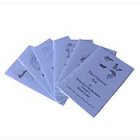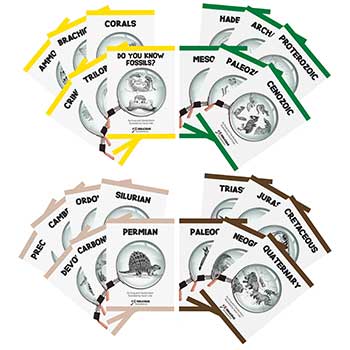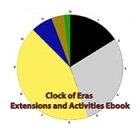Sign up for Lesson Plans, discounts & more!
A Step by Step Guide to Making Materials for Parts of a Fossil Lesson Plans.
The materials for the parts of fossil lesson plans are not commercially available. By following these instructions and using the PDF downloads at the bottom of this page you will be able to create a beautiful set of materials to compliment your parts of a fossil lesson plans, that will last for many years. Making the materials will also help you become familiar with vocabulary and make the lessons themselves easier to present. The instructions are generic and apply to all of the parts of lessons on www.fossils-facts-and-finds.com as well as any that you might like to make in the future.
- To begin download the PDF files below for the fossil lesson plans you will be making the materials for. Download the PDF file here for a free printable version of The parts of a crinoid Download the PDF file here for a free printable version of The Crinoid pictures for making materials for parts of a fossil lesson plans You will need pictures, labels, and descriptions for each set. You will need pictures for each part and one extra for the complete animal. It may be easier to print one picture and use a copy machine to make the appropriate number. You will also need card stock or fadeless art paper to mount the pictures, labels and descriptions. The colors are somewhat arbitrary. Just be consistant. If you are putting trilobites on blue cardstock use the same shade of blue in that set. If you are making materials for several phyla choose a different color for each phylum. For mounting the pictures cut the cardstock into 5 ½ inches X 5 ½ inches, one for each picture. For mounting labels cut the cardstock 5 ½” x 1 ½”. For mounting descriptions cut the cardstock 5 ½” x 5 ½ “. Optional: the descriptions cardstock can be 5 ½” wide and as long as the longest description plus the desired border.
- Cut the pictures, labels, and descriptions slightly smaller than the mounting stock so that there will be a uniform border of cardstock surrounding each element.

- Color your pictures highlighting one part in each picture as in the example. The picture for the complete animal can be colored realistically or left blank. The problem with realistic coloring is that we don’t know what color fossilized animals were. Color is not preserved in fossils. Artistic interpretation is a valid exercise and can be a point of interest to the children you are working with. Point out why you have choosen the colors you did and encourage them to imagine what colors these animals might have been.
- Mount the pictures, labels, and descriptions. Glue sticks are fast and easy.
After going to the trouble of making materials for the fossil lesson plans, you will want to laminate them to increase their durability. I like using 3 mil lamination film though 1 mil works. This will make one set of loose card material. Another set to make a booklet is recommended (see details below). The booklet will serve several purposes. It will provide a control of error enabling children to work with a minimum of help from teachers. It will also serve as an example for children to make their own fossil books.
The materials for a fossil booklet are made in a similar fashion to the loose cards with a few important exceptions. The loose cards are to allow the child practice working with the information, the booklets are the answer sheets. So…
The labels and descriptions are arranged opposite of their respective pictures.

Cardstock will all be the same size as in any book 5 ½” x 5 ½ “ is ideal.
Care must be taken in mounting because the labels and descriptions corresponding with one picture will be mounted on the back of another picture. The easiest way to avoid mistakes is to:
- Start with a cover page. This will have a picture and a lable.
- Mount all of the pictures each on it’s own page.
- Arrange the pictures in the order that you want them in cover page first.
- Turn the cover page and mount the label and description for the next picture.
- Mount the labels and descriptions opposite of their corresponding pictures one page at a time.
Note: Since this will be a book there will be some kind
of binding. Mount all pictures, labels, and descriptions slightly off
center (about ¼ “) to account for this. On the cover page mount the
picture ¼ “ to the right. On the next page they will be ¼” to the left.
When all the pages are mounted turn the pages of your book to make sure the the labels and descriptions match the pictures.
If everything lines up you are ready to laminate. Trim the lamination to the edge of the paper.
Binding
I prefer using plastic comb bindings. This requires a special machine to
cut rectangular holes and assemble the book. If you have access to a
binding machine great use it. If you do not have access to a binding
machine your local Kinko’s may be able to help you. Another choice is to
use rings. This is very simple. All you need is a hole punch and small
plastic rings. Punch 3 holes on each page, make sure that they line up.
Put the book together and put the rings on.
For more fossil lesson plans click here.
To see Earth Science Lesson Plans click here
For an overview on presenting the parts of a fossil lesson plans click here
Check out some of the Educational Materials for sale on our sister site fossilicious.com.

interested in more? If so, you may want to check out our other sites:
fossilicious.com - Our online fossil and mineral rock shop.
rocksandminerals4u.com - An educational site about rocks, minerals, and geology.
Geologic Time Geologic Time Line
Cenozoic Era
Quaternary
Neogene
Paleogene
Mesozoic Era
Cretaceous
Jurassic
Triassic
Paleozoic Era
Permian
Carboniferous
Devonian
Silurian
Ordovician
Cambrian
Archean Time
Hadean Time
Teachers Resources
Activities for Education and Fun
Earth Science Lesson Plans
Activities For Kids
Fossil Lesson Plans
Fossil Activities
Education Articles
Coloring Pages
Dinosaur Coloring Pages
Montessori Materials
Geology Club
Fossil Hunting
 |
 |
 |




